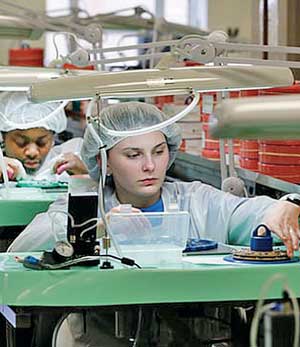Thursday Jan 09, 2025
Thursday Jan 09, 2025
Monday, 12 March 2018 00:05 - - {{hitsCtrl.values.hits}}
Washington (Reuters): The US economy added the biggest number of jobs in more than 1-1/2 years in February, but a slowdown in wage growth pointed to only a gradual increase in inflation this year.

Nonfarm payrolls jumped by 313,000 jobs last month, boosted by the largest rise in construction jobs since 2007, the Labour Department said on 9 March (Friday).
The payrolls gain was the most since July 2016 and triple the roughly 100,000 jobs the economy needs to create each month to keep up with growth in the working-age population. Data for December 2017 and January were revised to show the economy creating 54,000 more jobs than previously reported.
The labour market is benefiting from strong domestic demand, an improvement in global growth, and robust US business sentiment following passage of the Trump administration’s $1.5 trillion tax cut package. The tax cuts came into effect in January.
The blowout payrolls number cemented expectations the Federal Reserve will increase interest rates at its 20-21 March policy meeting. Sluggish wage growth, however, left economists divided on whether the US central bank would upgrade its rate forecast for this year to four hikes from three.
Average hourly earnings edged up four cents, or 0.1%, to $26.75 in February, a slowdown from the 0.3% rise in January. That lowered the year-on-year increase in average hourly earnings to 2.6% from 2.8% in January.
The unemployment rate was unchanged at a 17-year low of 4.1% in February for a fifth straight month as 806,000 people entered the labour force in a sign of confidence in the job market. The average workweek rebounded to 34.5 hours after falling to 34.4 hours in January.
Speculation that the central bank would upgrade its rate projections was stoked by Fed Chairman Jerome Powell when he told lawmakers last week that “my personal outlook for the economy has strengthened since December.”
Although Powell said there was no evidence of the economy overheating, he added “the thing we don’t want to have happen is to get behind the curve.”
Some economists expect the Fed to raise borrowing costs four times this year, arguing that wage growth was actually running stronger than suggested by average hourly earnings, which tend to be volatile on a monthly basis. Average hourly earnings for production and non-supervisory workers, which economists say are better measured, increased 0.3% in February.
Economists polled by Reuters had forecast payrolls rising by 200,000 jobs last month and the unemployment rate falling to 4.0%. Average hourly earnings had been expected to increase 0.2% in February.
The employment report suggested the economy remained strong despite weak consumer spending, home sales and industrial production and a wider trade deficit in January that prompted economists to lower their first-quarter growth estimates.
Gross domestic product estimates for the January-March quarter are around a 2% annualised rate. The economy grew at a 2.5% pace in the fourth quarter. But revisions to December 2017 data on construction spending, factory orders and wholesale inventory have suggested the fourth-quarter growth estimate could be raised to a 3.0% pace.
The full impact of the tax cuts and a planned increase in government spending has yet to be felt, and the hot job market could heighten fears of the economy overheating.
Economists expect the unemployment rate to fall to 3.5% this year. The labour force participation rate, or the proportion of working-age Americans who have a job or are looking for one, rose three-tenths of a percentage point to a five-month high of 63.0% in February.